Whirlpool YGY396LXGQ, YGY396LXGB, YGY395LXGQ, YGY395LXGZ, GY396LXGQ Owner's Manual
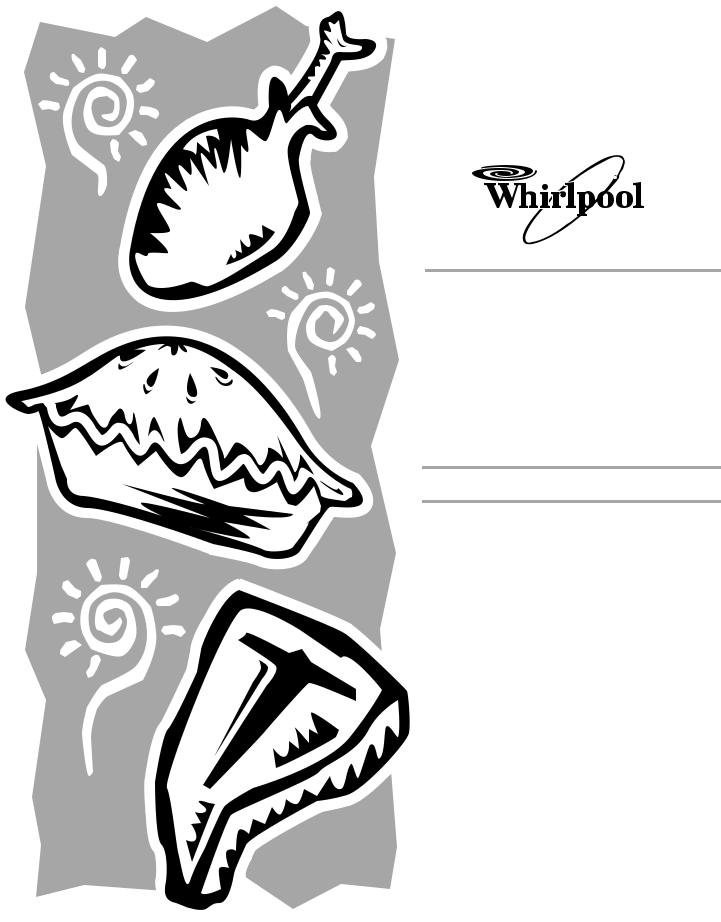
®
SELF-CLEANING
ELECTRIC RANGES
Use & Care Guide
For questions about features, operation/performance parts, accessories or service, call: 1-800-253-1301.
In Canada, call for assistance 1-800-461-5681, for installation and service, call: 1-800-807-6777
or visit our website at...
www.whirlpool.com or www.whirlpool.com/canada
Table of Contents ................................................. |
2 |
To the installer: please leave this instruction book with the unit.
To the consumer: please read and keep this book for future reference.
9752912B

TABLE OF CONTENTS |
|
RANGE SAFETY ............................................................................. |
3 |
The Anti-Tip Bracket .................................................................... |
3 |
PARTS AND FEATURES................................................................ |
6 |
COOKTOP USE .............................................................................. |
7 |
Cooktop Controls......................................................................... |
7 |
Elements....................................................................................... |
7 |
Warming Element......................................................................... |
7 |
Ceramic Glass Use ...................................................................... |
8 |
Fluorescent Cooktop Light .......................................................... |
8 |
Home Canning ............................................................................. |
8 |
Cookware ..................................................................................... |
9 |
ELECTRONIC OVEN CONTROL ................................................... |
9 |
Display.......................................................................................... |
9 |
Start .............................................................................................. |
9 |
Off ................................................................................................. |
9 |
Clock .......................................................................................... |
10 |
Tones.......................................................................................... |
10 |
Fahrenheit and Celsius............................................................... |
10 |
Timer........................................................................................... |
10 |
Control Lock............................................................................... |
10 |
Oven Temperature Control ........................................................ |
10 |
OVEN USE..................................................................................... |
11 |
Aluminum Foil............................................................................. |
11 |
Positioning Racks and Bakeware .............................................. |
11 |
Bakeware.................................................................................... |
11 |
Oven Vents ................................................................................. |
12 |
Oven Light .................................................................................. |
12 |
Bake............................................................................................ |
12 |
Timed Cooking ........................................................................... |
13 |
Broil ............................................................................................ |
13 |
Convection Cooking................................................................... |
14 |
Convection Bake........................................................................ |
14 |
Auto Convection Baking ............................................................ |
14 |
Convection Roast....................................................................... |
15 |
Convection Broil......................................................................... |
16 |
RANGE CARE ............................................................................... |
16 |
Self-Cleaning Cycle.................................................................... |
16 |
General Cleaning........................................................................ |
17 |
Control Panel Glass ................................................................... |
18 |
Oven Light .................................................................................. |
18 |
Cooktop Light Replacement...................................................... |
19 |
Appliance Outlets....................................................................... |
19 |
Oven Door .................................................................................. |
19 |
Storage Drawer .......................................................................... |
19 |
Sweep-Thru Base ...................................................................... |
19 |
TROUBLESHOOTING .................................................................. |
20 |
ASSISTANCE OR SERVICE......................................................... |
21 |
WARRANTY .................................................................................. |
24 |
2
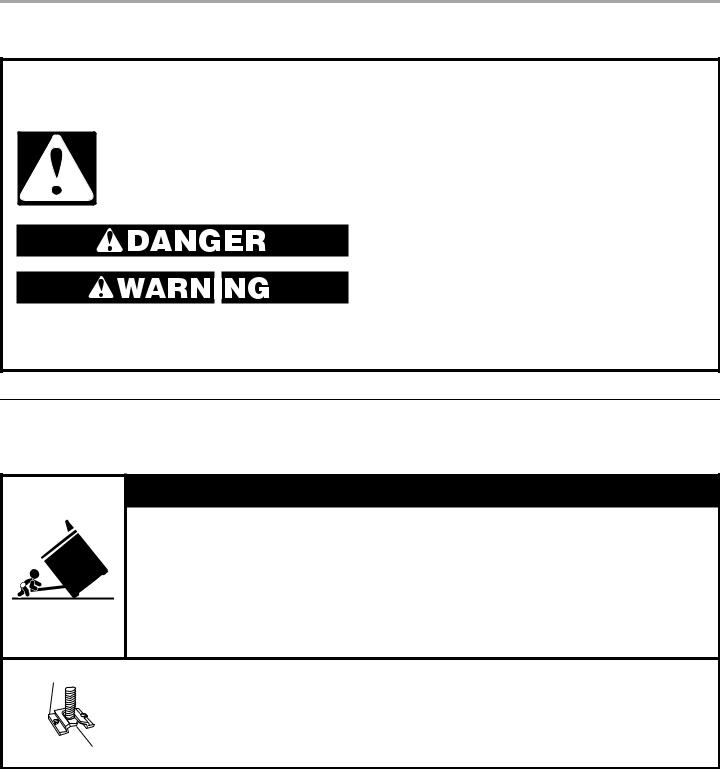
RANGE SAFETY
Your safety and the safety of others are very important.
We have provided many important safety messages in this manual and on your appliance. Always read and obey all safety messages.
This is the safety alert symbol.
This symbol alerts you to potential hazards that can kill or hurt you and others.
All safety messages will follow the safety alert symbol and either the word “DANGER” or “WARNING.” These words mean:
You can be killed or seriously injured if you don't immediately follow instructions.
You can be killed or seriously injured if you don't follow instructions.
All safety messages will tell you what the potential hazard is, tell you how to reduce the chance of injury, and tell you what can happen if the instructions are not followed.
TheAnti-Tip Bracket
The range will not tip during normal use. However, the range can tip if you apply too much force or weight to the open door without the anti-tip bracket fastened down properly.
 WARNING
WARNING
Tip Over Hazard
A child or adult can tip the range and be killed.
Connect anti-tip bracket to rear range foot.
Reconnect the anti-tip bracket, if the range is moved.
See the installation instructions for details.
Failure to follow these instructions can result in death or serious burns to children and adults.
Anti-Tip Bracket
Making sure the anti-tip bracket is installed:
• Slide range forward.
• Look for the anti-tip bracket securely attached to floor.
• Slide range back so rear range foot is under anti-tip bracket.
Range Foot
3

IMPORTANT SAFETY INSTRUCTIONS
WARNING: To reduce the risk of fire, electrical shock, injury to persons, or damage when using the range, follow basic precautions, including the following:
■ WARNING: TO REDUCE THE RISK OF TIPPING OF THE RANGE, THE RANGE MUST BE SECURED BY PROPERLY INSTALLED ANTI-TIP DEVICES. TO CHECK IF THE DEVICES ARE INSTALLED PROPERLY, SLIDE RANGE FORWARD, LOOK FOR ANTI-TIP BRACKET SECURELY ATTACHED TO FLOOR, AND SLIDE RANGE BACK SO REAR RANGE FOOT IS UNDER ANTI-TIP BRACKET.
■ CAUTION: Do not store items of interest to children in cabinets above a range or on the backguard of a range – children climbing on the range to reach items could be seriously injured.
■Proper Installation – Be sure the range is properly installed and grounded by a qualified technician.
■Never Use the Range for Warming or Heating the Room.
■Do Not Leave Children Alone – Children should not be left alone or unattended in area where the range is in use. They should never be allowed to sit or stand on any part of the range.
■Wear Proper Apparel – Loose-fitting or hanging garments should never be worn while using the range.
■User Servicing – Do not repair or replace any part of the range unless specifically recommended in the manual. All other servicing should be referred to a qualified technician.
■Storage in or on the Range – Flammable materials should not be stored in an oven or near surface units.
■Do Not Use Water on Grease Fires – Smother fire or flame or use dry chemical or foam-type extinguisher.
■Use Only Dry Potholders – Moist or damp potholders on hot surfaces may result in burns from steam. Do not let potholder touch hot heating elements. Do not use a towel or other bulky cloth.
■DO NOT TOUCH SURFACE UNITS OR AREAS NEAR UNITS – Surface units may be hot even though they are dark in color. Areas near surface units may become hot enough to cause burns. During and after use, do not touch, or let clothing or other flammable materials contact surface units or areas near units until they have had sufficient time to cool. Among those areas are the cooktop and surfaces facing the cooktop.
■Use Proper Pan Size – The range is equipped with one or more surface units of different size. Select utensils having flat bottoms large enough to cover the surface unit heating element. The use of undersized utensils will expose a portion of the heating element to direct contact and may result in ignition of clothing. Proper relationship of utensil to burner will also improve efficiency.
■Never Leave Surface Units Unattended at High Heat Settings – Boilover causes smoking and greasy spillovers that may ignite.
■Make Sure Reflector Pans or Drip Bowls Are in Place – Absence of these pans or bowls during cooking may subject wiring or components underneath to damage.
■Protective Liners – Do not use aluminum foil to line surface unit drip bowls or oven bottoms, except as suggested in the manual. Improper installation of these liners may result in a risk of electric shock, or fire.
■Glazed Cooking Utensils – Only certain types of glass, glass/ceramic, ceramic, earthenware, or other glazed utensils are suitable for range-top service without breaking due to the sudden change in temperature.
■Utensil Handles Should Be Turned Inward and Not Extend Over Adjacent Surface Units – To reduce the risk of burns, ignition of flammable materials, and spillage due to unintentional contact with the utensil, the handle of a utensil should be positioned so that it is turned inward, and does not extend over adjacent surface units.
■Do Not Soak Removable Heating Elements – Heating elements should never be immersed in water.
■Do Not Cook on Broken Cooktop – If cooktop should break, cleaning solutions and spillovers may penetrate the broken cooktop and create a risk of electric shock. Contact a qualified technician immediately.
■Clean Cooktop With Caution – If a wet sponge or cloth is used to wipe spills on a hot cooking area, be careful to avoid steam burn. Some cleaners can produce noxious fumes if applied to a hot surface.
■Use Care When Opening Door – Let hot air or steam escape before removing or replacing food.
■Do Not Heat Unopened Food Containers – Build-up of pressure may cause container to burst and result in injury.
SAVE THESE INSTRUCTIONS
4

IMPORTANT SAFETY INSTRUCTIONS
■Keep Oven Vent Ducts Unobstructed.
■Placement of Oven Racks – Always place oven racks in desired location while oven is cool. If rack must be moved while oven is hot, do not let potholder contact hot heating element in oven.
■DO NOT TOUCH HEATING ELEMENTS OR INTERIOR SURFACES OF OVEN – Heating elements may be hot even though they are dark in color. Interior surfaces of an oven become hot enough to cause burns. During and after use, do not touch, or let clothing or other flammable materials contact heating elements or interior surfaces of oven until they have had sufficient time to cool. Other surfaces of the appliance may become hot enough to cause burns – among these surfaces are oven vent openings and surfaces near these openings, oven doors, and windows of oven doors.
For self-cleaning ranges –
■Do Not Clean Door Gasket – The door gasket is essential for a good seal. Care should be taken not to rub, damage, or move the gasket.
■Do Not Use Oven Cleaners – No commercial oven cleaner or oven liner protective coating of any kind should be used in or around any part of the oven.
■Clean Only Parts Listed in Manual.
■Before Self-Cleaning the Oven – Remove broiler pan and other utensils.
For units with ventilating hood –
■Clean Ventilating Hoods Frequently – Grease should not be allowed to accumulate on hood or filter.
■When flaming foods under the hood, turn the fan on.
SAVE THESE INSTRUCTIONS
5
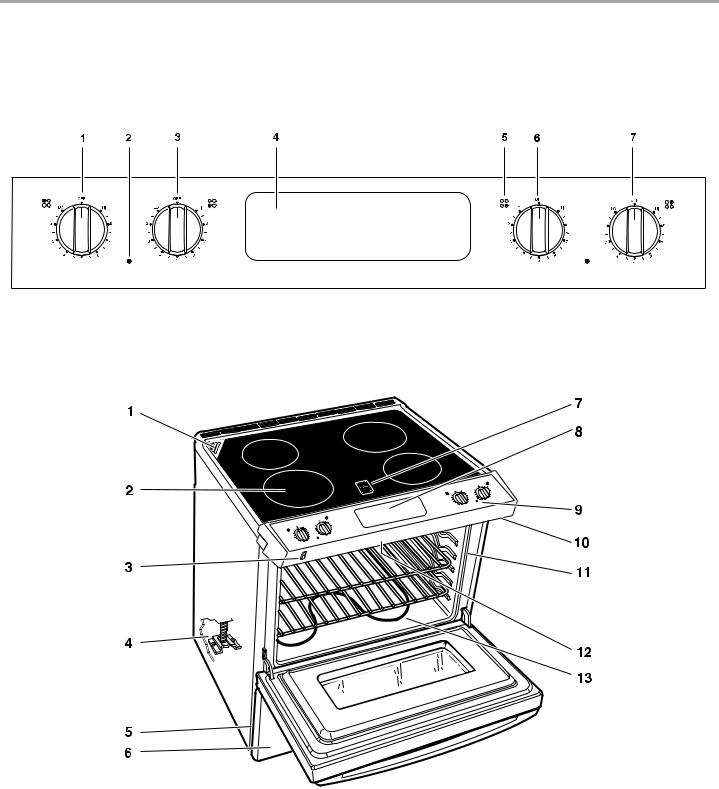
PARTS AND FEATURES
This manual covers several different models. The range you have purchased may have some or all of the items listed. The locations and appearances of the features shown here may not match those of your model.
Control Panel
1. |
Left Front Control Knob |
4. |
Electronic Oven Control |
6. |
Right Rear Control Knob |
2. |
Surface Heating Indicator Light |
5. |
Surface Cooking Area Locator |
7. |
Right Front Control Knob |
3. |
Left Rear Control Knob |
|
|
|
|
Range
1. |
Oven Vent |
5. |
Model and Serial Number Plate |
10. |
Automatic Oven Light Switch |
2. |
Surface Cooking Area |
|
(behind left side of storage drawer) |
|
(underneath control panel) |
3. |
Manual Oven Light Switch |
6. |
Removable Storage Drawer |
11. |
Gasket |
|
(on some models) |
7. |
Hot Surface Indicator Light |
12. |
Broil Element (not visible) |
4. |
Anti-Tip Bracket |
8. |
Electronic Oven Control |
13. |
Bake Element |
|
|
9. |
Control Panel |
|
|
6
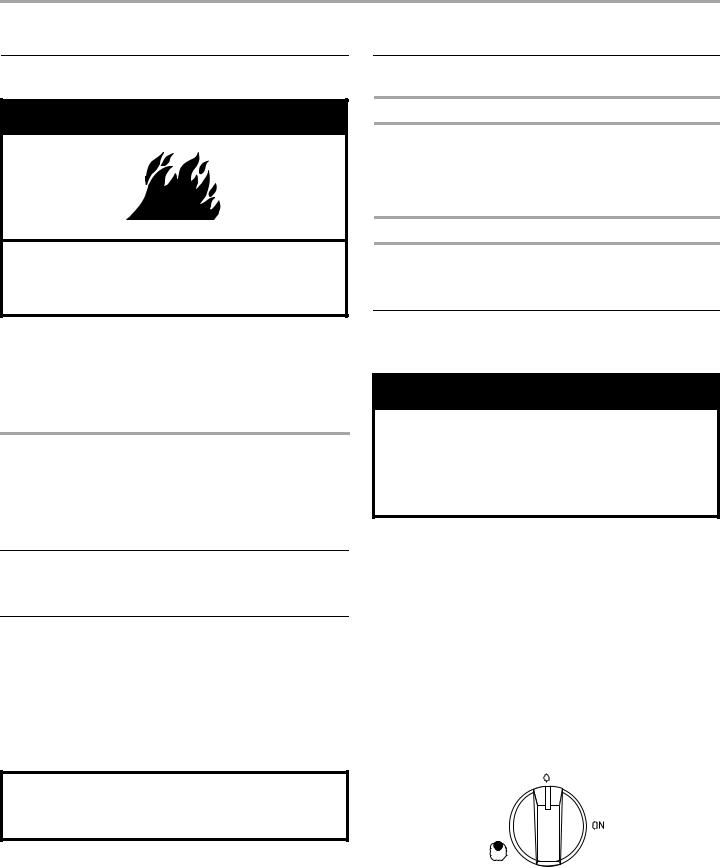
COOKTOP USE
CooktopControls
 WARNING
WARNING
Fire Hazard
Turn off all controls when done cooking.
Failure to do so can result in death or fire.
Control knobs must be pushed in before turning them to a setting. The controls can be set anywhere between HI and “0” (OFF).
On models with Ceramic Glass, the controls work on the principle of percent on, percent off. When the control is turned to setting 5, the element will be on 50% of the time.
Use the following chart as a guide when setting heat levels.
SETTING |
RECOMMENDED USE |
|
|
|
|
HI |
■ To start foods cooking. |
|
|
■ To bring liquids to a boil. |
|
|
|
|
8-6 |
■ |
To hold a rapid boil. |
|
■ |
To quickly brown or sear meat. |
5■ To cook gravy, pudding or sauce.
■To fry poultry or meat.
■To maintain a slow boil.
4-2 |
■ |
To stew or steam food. |
|
■ |
To simmer food. |
|
|
|
LO |
■ |
To keep foods warm. |
|
■ |
To melt chocolate. |
|
|
|
Simmer Element |
■ |
Precise simmer control. |
(on some models) |
|
|
Elements
Quick Light Radiant Heating Elements
The quick light radiant heating elements are designed for fast heat response. You can see them light up in just seconds. These elements consist of a set of special heater coils embedded in a thermal insulation material. You may notice the element going on and off a number of times during use. This is a normal occurrence.
Simmer Element (on some models)
The simmer element is identified on the disc in the center of the element. This element can maintain lower temperatures for preparation of foods that require very low heat such as sauces, chocolate or cheese.
Warming Element
(on ceramic glass models)
 WARNING
WARNING
Food Poisoning Hazard
Do not let food sit for more than one hour before or after cooking.
Doing so can result in food poisoning or sickness.
Use the Warming Element to keep cooked foods warm. One hour is the recommended maximum time to maintain food quality.
Do not use it to heat cold foods.
The Warming Element can be used alone or when any of the other surface cooking areas are being used. The Warming Element area will not glow red when cycling on. However, its indicator light will glow as long as the Warming Element area is too hot to touch.
■Use only cookware and dishes recommended for oven and cooktop use.
■Cover all foods with a lid or aluminum foil. When warming baked goods, allow a small opening in the cover for moisture to escape.
■Do not use plastic wrap to cover food. Plastic wrap may melt.
■You might want to use pot holders or oven mitts to remove cookware.
REMEMBER: When range is in use or (on some models) during the Self-Cleaning cycle, the entire cooktop area may become hot.
Power On Lights
The Power On lights beside the control knobs indicate which surface elements are turned on. A Power On light will glow when its corresponding surface element is turned on.
To Use:
1.Set switch to ON. The light will glow red.
2.Set switch to OFF when finished.
7

Ceramic Glass Use
The surface cooking area will glow red when an element is on. It will cycle on and off, at all settings, to maintain the selected heat level.
It is normal for the surface of white ceramic glass to appear to change color when surface cooking areas are hot. As the glass cools, it will return to its original color.
Wiping off the cooktop before and after each use will help keep it free from stains and provide the most even heating. For more information, see “General Cleaning” section.
■Do not store jars or cans above the cooktop. Dropping a heavy or hard object onto the cooktop could crack it.
■Do not leave a hot lid on the cooktop. As the cooktop cools, air can become trapped between the lid and the cooktop, and the ceramic glass could break when the lid is removed.
■For foods containing sugar in any form, clean up all spills and soils as soon as possible. Allow the cooktop to cool down slightly; then, remove the spills while the surface is still warm. If sugary spills are allowed to cool down, they can adhere to the cooktop and can cause pitting and permanent marks.
■Do not slide cookware or bakeware across the cooktop. Aluminum or copper bottoms and rough finishes on cookware or bakeware could leave scratches or marks on the cooktop.
■Do not cook popcorn in prepackaged aluminum containers on the cooktop. They could leave aluminum marks that cannot be removed completely.
■Do not allow objects that could melt, such as plastic or aluminum foil, to touch any part of the entire cooktop.
■Do not use the cooktop as a cutting board.
■Use cookware about the same size as the surface cooking area. Cookware should not extend more than 1 in. (2.5 cm) outside the area.
HOT Surface Indicator Lights
■Single HOT surface indicator light (on some models)
HOT
CHAUD
■Four or five HOT surface indicator lights (on other models)
■Five HOT surface indicator lights (on models equipped with Warming Element)
The HOT surface indicator lights on the cooktop surface will glow when their corresponding surface elements are turned on. The HOT surface indicator lights will continue to glow as long as the elements are too hot to touch, even after they are turned off.
FluorescentCooktopLight
(onsomemodels)
The cooktop light is in the top of the control console. The switch in on the control console. Push the switch to turn the light on. The light may take a few seconds to light up.
1.Surface Cooking Area
2.Cookware/Canner
3.1 in. (2.5 cm) Maximum Overhang
■Use flat-bottomed cookware for best heat conduction and energy efficiency. Cookware with rounded, warped, ribbed or dented bottoms could cause uneven heating and poor cooking results.
■Determine flatness by placing the straight edge of a ruler across the bottom of the cookware. While you rotate the ruler, no space or light should be visible between it and the cookware.
■Cookware designed with slightly indented bottoms or small expansion channels can be used.
■Make sure the bottoms of pots and pans are clean and dry before using them. Residue and water can leave deposits when heated.
■Do not cook foods directly on the cooktop.
Home Canning
When canning for long periods, alternate the use of surface cooking areas, elements or surface burners between batches. This allows time for the most recently used areas to cool.
■Center the canner on the grate or largest surface cooking area or element. Canners should not extend more than 1 in. (2.5 cm) outside the cooking area.
■Do not place canner on two surface cooking areas, elements or surface burners at the same time.
■On ceramic glass models, use only flat-bottomed canners.
■On coil element models, the installation of a Canning Unit Kit is recommended. If a kit is not installed, the life of the coil element will be shortened.
■For more information, contact your local agricultural department. Companies that manufacture home canning products can also offer assistance.
8
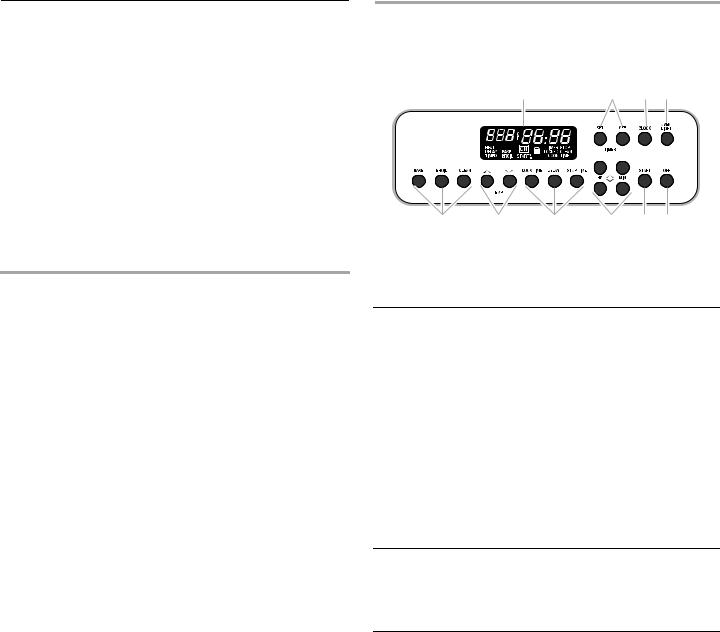
Cookware
IMPORTANT: Never leave empty cookware on a hot surface cooking area, element or surface burner.
Ideal cookware should have a flat bottom, straight sides, a wellfitting lid and the material should be of medium-to-heavy thickness.
Rough finishes may scratch the cooktop. Aluminum and copper may be used as a core or base in cookware. However, when used as a base, they can leave permanent marks on the cooktop or grates.
Cookware material is a factor in how quickly and evenly heat is transferred, which affects cooking results. A nonstick finish has the same characteristics as its base material. For example, aluminum cookware with a nonstick finish will take on the properties of aluminum.
Use the following chart as a guide for cookware material characteristics.
COOKWARE |
CHARACTERISTICS |
|
|
|
|
Aluminum |
■ Heats quickly and evenly. |
|
|
■ Suitable for all types of cooking. |
|
|
■ Medium or heavy thickness is best for |
|
|
|
most cooking tasks. |
|
|
|
Cast iron |
■ Heats slowly and evenly. |
|
|
■ Good for browning and frying. |
|
|
■ Maintains heat for slow cooking. |
|
|
|
|
Ceramic or |
■ |
Follow manufacturer’s instructions. |
Ceramic glass |
■ Heats slowly, but unevenly. |
|
|
||
|
■ Ideal results on low to medium heat |
|
|
|
settings. |
|
|
|
Copper |
■ Heats very quickly and evenly. |
|
|
|
|
Earthenware |
■ |
Follow manufacturer’s instructions. |
|
■ Use on low heat settings. |
|
|
|
|
Porcelain |
■ See stainless steel or cast iron. |
|
enamel- |
|
|
on-steel or |
|
|
cast iron |
|
|
|
|
|
Stainless steel |
■ Heats quickly, but unevenly. |
|
|
■ A core or base of aluminum or copper |
|
on stainless steel provides even heating.
ELECTRONIC OVEN
CONTROL
1 |
2 |
3 |
4 |
|
5 |
|
6 |
7 |
|
8 |
9 |
10 |
1. |
Display |
4. |
Oven Light |
|
7. |
Timed Cooking |
||
2. |
Timer |
5. |
Oven Settings |
|
8. |
Hour and Minute |
||
3. |
Clock |
6. |
Temperature Setting |
9. |
Start and Control |
|||
|
|
|
|
|
|
Lock/Off |
|
|
Display
When power is first supplied to the appliance, everything on the display will light up for 1 to 2 seconds, then a time of day and “PF” will appear. Press OFF to clear “PF” from the display.
If “PF” appears at any other time, a power failure has occurred. Press OFF and reset the clock if needed.
When the oven is in use, the display shows preheat time and the temperature and oven setting.
When the oven is not in use, the display shows the time of day.
When using the TIMER, for settings of 1 to 59 minutes, the display will count down in seconds. For settings 1 hour or over, the display will count down hours and minutes.
When using COOK TIME, the display will show hours and minutes. When using STOP TIME, the display will show minutes and seconds.
Start
After setting a function, you must press the START button to start the function. If you do not press the START button within 5 seconds, “START?” will be displayed as a reminder.
Off
The OFF button stops any function except the Clock, Timer and Control Lock. When you press the OFF button, the display will show the time of day, or the time remaining if the TIMER is being used.
9

Clock
On some models, if you do not want the clock time to be displayed, press and hold the CLOCK pad (button) for 5 seconds. When the clock is not displayed, you can see the time for 5 seconds by pressing the CLOCK pad (button).
To Set:
Before setting, make sure the oven, TIMER and COOK TIME are off.
1.Press CLOCK.
2.Press the HR or MIN “up” or “down” arrow pads (buttons) to set the time of day.
3.Press CLOCK or START.
Tones
Tones are audible signals that indicate whether a function has been entered correctly, or when a cycle has ended.
To shut off all tones except the end-of-timer and error tones:
1.Press and hold the STOP TIME button for 5 seconds.
2.A short tone will sound when the tones have been changed. To turn tones back on, repeat step 1.
3.“OFF” will be displayed for 3 seconds when the tones have been turned off, and “ON” will be displayed for 3 seconds when the tones have been turned back on.
To choose between high and low volume tones:
1.Press and hold the DELAY button for 5 seconds.
2.A short tone will sound indicating the tones have been changed.
3.Either “HI” or “Lo” will appear on the display for 3 seconds to show the volume you have chosen.
Fahrenheit and Celsius
The temperature is preset at Fahrenheit, but can be changed to Celsius.
To Change: Press and hold BROIL for 5 seconds. A tone will sound and “°C” will appear on the lower oven display for 3 seconds. Repeat to change back to Fahrenheit.
When in Fahrenheit, “°F” follows the oven temperature.
When in Celsius, “°C” follows the oven temperature.
Timer
The Timer can be set in hours or minutes up to 12 hours and 59 minutes, and counts down the set time.
NOTE: The Timer does not start or stop the oven.
To Set:
1.Press TIMER SET.
If no action is taken after one minute, the display will return to the time of day mode.
2.Press the HR or MIN “up” or “down” arrow pads (buttons) to set the length of time.
3.Press START.
If not pressed within 5 seconds, the display will return to the time of day mode and the programmed function will be canceled.
When the set time ends, end-of-cycle tones will sound, then, if on, reminder tones will sound every minute.
4.Press TIMER OFF anytime to cancel the Timer.
Remember, do not press the OFF pad (button) because the oven will turn off.
To display the time of day when the timer is counting down, press CLOCK.
ControlLock
The Control Lock shuts down the control panel pads (buttons) to prevent unintended use of the oven(s).
When the control is locked, only the CLOCK, TIMER SET and TIMER OFF pads (buttons) will function.
The Control Lock is preset unlocked, but can be locked.
To Lock/Unlock Control: Before locking, make sure the oven, Timer and Timed Cooking (COOK TIME on some models) are off. Press and hold START for 5 seconds, or until a single tone sounds, “LOC” and a picture of a lock appear on the display. Repeat to unlock and remove “LOC” from display.
Oven TemperatureControl
IMPORTANT: Do not use a thermometer to measure oven temperature because opening the oven door and element or burner cycling may give incorrect readings.
The oven provides accurate temperatures; however, it may cook faster or slower than your previous oven, so the temperature calibration can be adjusted. It can be changed in Fahrenheit
or Celsius.
A minus sign means the oven will be cooler by the displayed amount. No sign means the oven will be warmer by the displayed amount. Use the following chart as a guide.
ADJUSTMENT °F |
COOKS FOOD |
(ADJUSTMENT °C) |
|
|
|
5° to 10°F (3° to 6°C) |
...a little more |
|
|
15° to 20°F (9° to 12°C) |
...moderately more |
|
|
25° to 35°F (15° to 21°C) |
...much more |
|
|
-5° to -10°F (-3° to -6°C) |
...a little less |
|
|
-15° to -20°F (-9° to -12°C) |
...moderately less |
|
|
-25° to -35°F (-15° to -21°C) |
...much less |
|
|
To Adjust Oven Temperature Calibration:
1.Press and hold BAKE for 5 seconds until the oven display shows the current calibration, for example “0° CAL.”
2.Press the TEMP “up” or “down” arrow pads (buttons) to increase or to decrease the temperature in 10°F (6°C) amounts. The adjustment can be set between 30°F (18°C) and -30°F (-18°C).
3.Press START.
To Display Temperatures in °C instead of °F:
Press and hold the BROIL button for 5 seconds. A short tone will sound, and the temperature display will switch to °C. Repeat to switch back to °F.
10
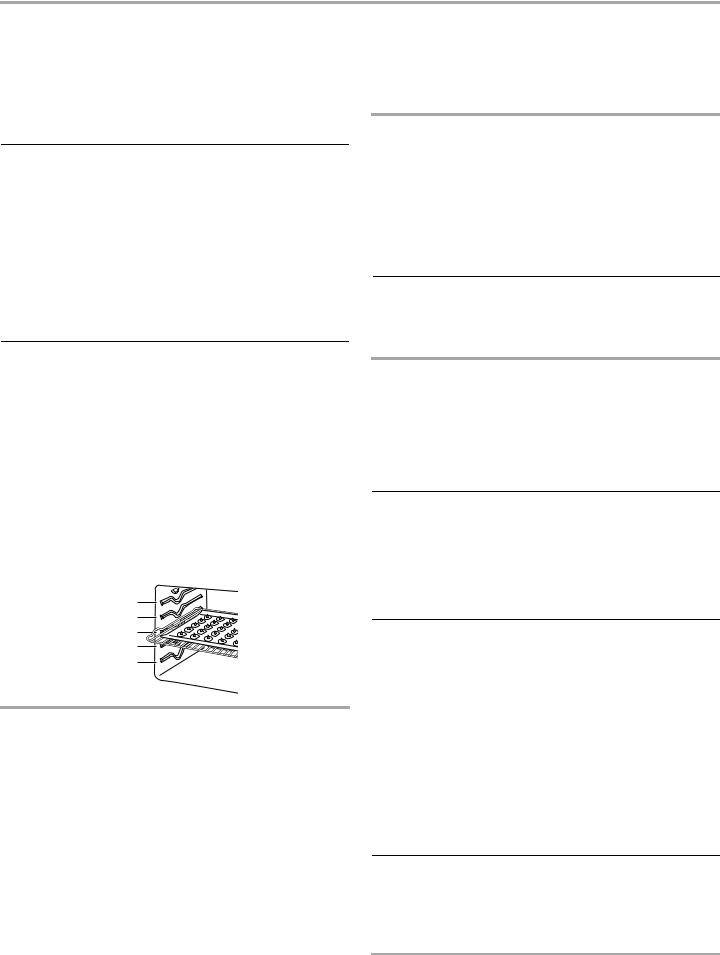
OVEN USE
Odors and smoke are normal when the oven is used the first few times, or when it is heavily soiled.
IMPORTANT: The health of some birds is extremely sensitive to the fumes given off. Exposure to the fumes may result in death to certain birds. Always move birds to another closed and well ventilated room.
Aluminum Foil
IMPORTANT: Do not line the oven bottom with any type of foil, liners or cookware because permanent damage will occur to the oven bottom finish.
■Do not cover entire rack with foil because air must be able to move freely for best cooking results.
■To catch spills, place foil on rack below dish. Make sure foil is at least 1 in. (2.5 cm) larger than the dish and that it is turned up at the edges.
■Do not cover food with aluminum foil when convection cooking (on some models).
Positioning Racks and Bakeware
IMPORTANT: Never place food or bakeware directly on the oven door or bottom. Permanent damage will occur to the porcelain finish.
RACKS
NOTES:
■Position racks before turning the oven on.
■Do not move racks with bakeware on them.
■Make sure racks are level.
To move a rack, pull it out to the stop position, raise the front edge, and then lift out. Use the following illustration and chart as a guide.
5
4
3
2
1
FOOD |
RACK POSITION |
|
|
Frozen pies, large roasts, turkeys, |
1 or 2 |
angel food cakes |
|
|
|
Bundt cakes, most quick breads, |
2 |
yeast breads, casseroles, meats |
|
|
|
Cookies, biscuits, muffins, cakes, |
2 or 3 |
nonfrozen pies |
|
|
|
BAKEWARE
To cook food evenly, hot air must be able to circulate. Allow 2 in. (5 cm) of space around bakeware and oven walls. Use the following chart as a guide.
NUMBER OF |
POSITION ON RACK |
PAN(S) |
|
|
|
1 |
Center of rack. |
|
|
2 |
Side by side or slightly staggered. |
|
|
3 or 4 |
Opposite corners on each rack. Make sure |
|
that no bakeware piece is directly over |
|
another. |
Bakeware
The bakeware material affects cooking results. Follow manufacturer’s recommendations and use the bakeware size recommended in the recipe. Use the following chart as a guide.
BAKEWARE/ |
RECOMMENDATIONS |
RESULTS |
|
|
|
Light colored |
■ Use temperature and time |
aluminum |
recommended in recipe. |
■Light golden crusts
■Even browning
Dark aluminum and other bakeware with dark, dull and/or nonstick finish
■Brown, crisp crusts
■May need to reduce baking temperatures 25°F (15°C).
■Use suggested baking time.
■For pies, breads and casseroles, use temperature recommended in recipe.
■Place rack in center of oven.
Insulated cookie |
■ |
Place in the bottom third of oven. |
||
sheets or |
■ |
May need to increase baking time. |
||
baking pans |
||||
|
|
|||
■ |
Little or no |
|
|
|
|
bottom |
|
|
|
|
browning |
|
|
|
|
|
|
||
Stainless steel |
■ |
May need to increase baking time. |
||
■ |
Light, golden |
|
|
|
|
crusts |
|
|
|
■ |
Uneven |
|
|
|
|
browning |
|
|
|
|
|
|
||
Stoneware |
■ |
Follow manufacturer’s instructions. |
||
■Crisp crusts
Ovenproof |
■ May need to reduce baking |
glassware, |
temperatures 25°F (15°C). |
ceramic glass |
|
or ceramic |
|
■Brown, crisp crusts
11
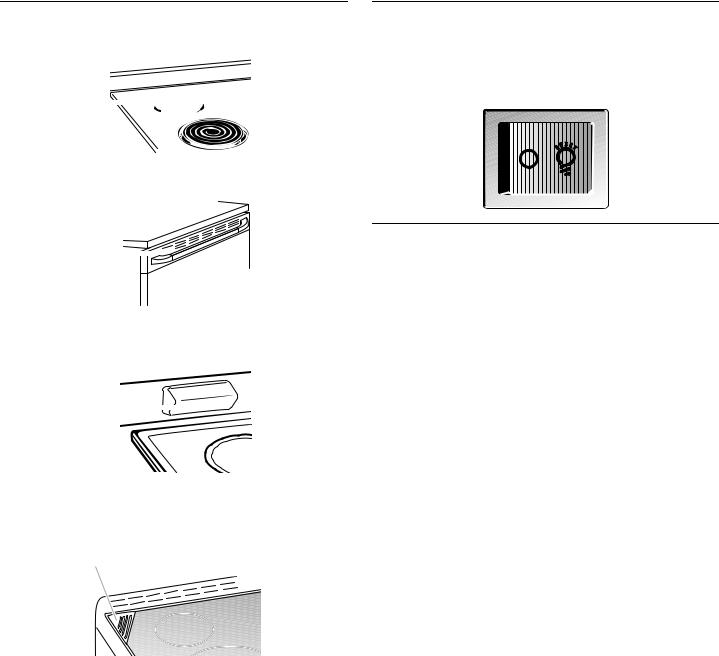
OvenVents
1 

1. Oven vent coil element cooktop models
1 

1. Oven door vent
1 

1. Oven vent free-standing ranges
1
1. Oven vent slide-in ranges
The oven vents should not be blocked or covered because they allow the release of hot air and moisture from the oven. Blocking and covering the vents will cause poor air circulation, affecting cooking and cleaning results. Never set plastics, paper or other items that could melt or burn near the oven vents. Some condensation may occur, however this will not affect cooking performance.
OvenLight
(onsomemodels)
The oven light is turned on by the switch located on the control console. The oven does not need to be on for the light to come on.
Bake
The oven automatically regulates the heat levels and both the top and bottom elements cycle on and off accordingly during preheat and bake to maintain a precise temperature range for optimal cooking results.
To Bake or Roast:
Before baking and roasting, position the racks according to the “Positioning Racks and Bakeware” section. When roasting, it is not necessary to wait for the oven to preheat before putting food in, unless recommended in the recipe.
1.Press BAKE.
Press the TEMP “up” or “down” arrow pads (buttons) to enter a temperature other than 350°F (175°C). Press the “up” or “down” pads (buttons) to raise or lower the temperature in increments of 5°F or 5°C.
2.Press START.
A preheat time will count down and “PrE” will appear on the display. The oven control automatically sets preheating times based on the oven temperature you select.
When the actual oven temperature is reached, the set temperature will replace “PrE” on the display.
When the set temperature is reached, if on, one tone will sound.
3.Press OFF when finished cooking.
The temperature can be changed any time after pressing START.
Preheating
Preheat temperatures are affected by varying factors such as room temperature and peak energy usage times. It is normal for the temperature showing on the display and the actual oven temperature to differ.
Waiting an additional 10 minutes after the preheat conditioning time ends to put food in the oven is suggested when baking foods with leavening ingredients, such as yeast, baking powder, baking soda and eggs.
12

Timed Cooking
 WARNING
WARNING
Food Poisoning Hazard
Do not let food sit in oven more than one hour before or after cooking.
Doing so can result in food poisoning or sickness.
Timed Cooking allows the oven to be set to turn on at a certain time of day, cook for a set length of time, and/or shut off automatically. Delay start should not be used for food such as breads and cakes because they may not bake properly.
To Set a Cook Time:
1.Press an oven function.
Press the TEMP “up” or “down” arrow pads (buttons) to enter a temperature other than 350°F (175°C).
2.Press COOK TIME.
3.Press the HR and MIN “up” or “down” arrow pads (buttons) until the correct time shows on the display.
4.Press START.
The display will count down the time in hours and minutes if the cook time is more than 1 hour, and in minutes and seconds if the cook time is less than 1 hour.
When the stop time is reached, the oven will shut off automatically and “End” will appear on the oven display.
If on, end-of-cycle tones will sound.
5.Press OFF.
You can do this step at any time to cancel timed cooking.
To Set a Cook Time and Stop Time:
Before setting, make sure the clock is set to the correct time of day. See “Clock” section.
1.Press an oven function.
Press the number pads (buttons) to enter a temperature other than the one displayed.
Press the TEMP “up” or “down” arrow pads (buttons) to enter a temperature other than 350°F (175°C).
2.Press COOK TIME.
3.Press number pads to enter the length of time to cook.
Press the HR and MIN “up” or “down” arrow pads (buttons) until the correct time shows on the display.
4.Press STOP TIME.
5.Press the number pads to enter time of day to stop.
Press the HR and MIN “up” or “down” arrow pads (buttons) until the correct time shows on the display.
6.Press START.
The start time is automatically calculated and displayed.
When the stop time is reached, the oven will shut off automatically and “End” will appear on the oven display.
If on, end-of-cycle tones will sound.
7.Press OFF.
You can do this step at any time to cancel timed cooking.
Broil
The top element operates at full power when heating.
Use this setting for normal broiling and top browning with the door open in the Broil Stop position.
■Use only the broiler pan and grid provided with the range. It is designed to drain juices and help prevent spatter and smoke.
■For proper draining, do not cover the grid with foil. The bottom of the pan may be lined with aluminum foil for easier cleaning.
■Trim excess fat to reduce spattering. Slit the remaining fat on the edges to prevent curling.
■Pull out oven rack to stop position before turning or removing food. Use tongs to turn food to avoid the loss of juices. Very thin cuts of fish, poultry or meat may not need to be turned.
■After broiling, remove the pan from the oven when removing the food. Drippings will bake on the pan if left in the heated oven, making cleaning more difficult.
To Broil:
Before broiling, position the rack according to the Broiling Chart.
Position food on the grid in the broiler pan, then place it in the center of the oven rack with the longest side parallel to the door. It is not necessary to preheat the oven before putting food in, unless recommended in the recipe.
Leave the door partly open when you use the oven to broil. This allows the oven to stay at the proper temperature.
1.Press BROIL.
2.Press START.
The set oven temperature will appear on the display until the oven is turned off.
3.Press OFF when finished cooking.
To Vari Broil:
Changing the temperature when custom broiling allows more precise control when cooking. The lower the temperature, the slower the cooking. Thicker cuts and unevenly shaped pieces of meat, fish and poultry may cook better at lower broiling temperatures.
1.Press BROIL.
Press the TEMP “up” or “down” arrow pads (buttons) to enter a temperature other than 500°F (260°C). The broil range can be set between 300°F (150°C) and 525°F (275°C).
2.Press START.
The set oven temperature will appear on the oven display until the oven is turned off.
3.Press OFF when finished cooking.
BROILING CHART
For best results, place food 3 in. (7 cm) or more from the broil element. Times are guidelines only and may need to be adjusted for individual foods and tastes. Recommended rack positions are
13
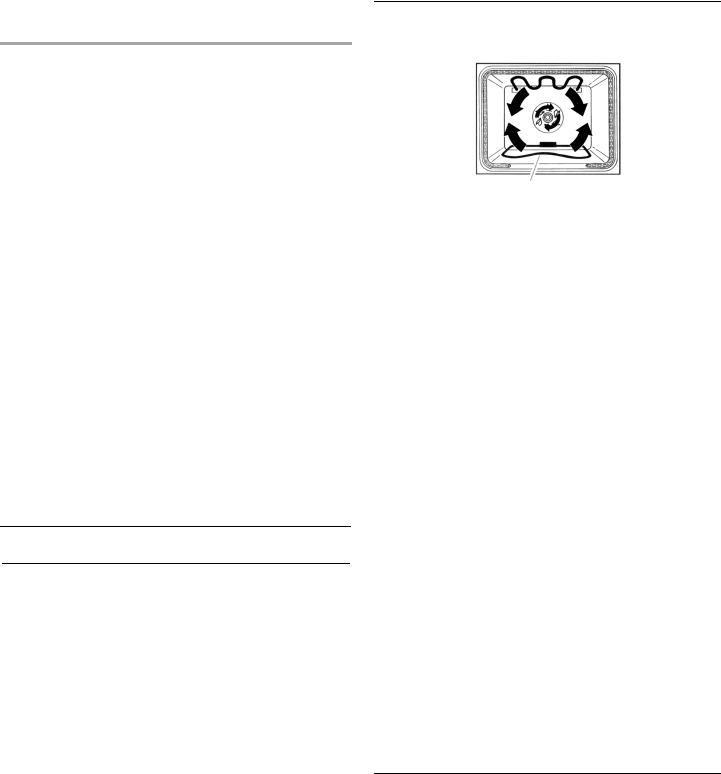
numbered from the bottom (1) to the top (4). Do not use position 5. For diagram, see the “Positioning Racks and Bakeware” section.
|
RACK |
COOK TIME |
|
|
minutes |
|
|
FOOD |
POSITION |
SIDE 1 |
SIDE 2 |
|
|
||
|
|
|
|
Chicken |
|
|
|
bone-in pieces |
3 |
17-20 |
17-20 |
boneless breasts |
4 |
11-16 |
11-16 |
|
|
|
|
Fish |
|
|
|
Fillets ¹- ¹ in. |
4 |
8-10 |
4-5 |
(.6-1.25 cm) thick |
|
|
|
Steaks ³- 1 in. |
4 |
16-18 |
8-9 |
(2-2.5 cm) thick |
|
|
|
|
|
|
|
Frankfurters |
4 |
5-7 |
3-4 |
|
|
|
|
Ground meat patties* |
|
|
|
³ in. (2 cm) thick |
|
|
|
well done |
4 |
13-14 |
7-8 |
|
|
|
|
Ham slice, precooked |
|
|
|
¹ in. (1.25 cm) thick |
4 |
8-10 |
4-5 |
|
|
|
|
Lamb chops |
|
|
|
1 in. (2.5 cm) thick |
4 |
14-17 |
8-9 |
|
|
|
|
Pork chops |
|
|
|
1 in. (2.5 cm) thick |
4 |
20-22 |
10-11 |
|
|
|
|
Steak |
|
|
|
1 in. (2.5 cm) thick |
|
|
|
medium rare |
4 |
14-15 |
7-8 |
medium |
4 |
15-16 |
8-9 |
well done |
4 |
18-19 |
9-10 |
*Place up to 12 patties, equally spaced, on broiler grid.
Convection Cooking
(onsomemodels)
In a convection oven, the fan-circulated hot air continually distributes heat more evenly than the natural movement of air in a standard thermal oven. This movement of hot air maintains a consistent temperature throughout the oven, cooking foods more evenly, crisping surfaces while sealing in moisture and yielding crustier breads.
Most foods can be cooked by lowering cooking temperatures 25°F to 50°F (14°C to 28°C) and cooking time can be shortened by as much as 30 percent, especially for large turkeys and roasts.
■It is important not to cover foods so that surface areas remain exposed to the circulating air, allowing browning and crisping.
■Keep heat loss to a minimum by opening the oven door only when necessary.
■Choose cookie sheets without sides and roasting pans with lower sides to allow air to move freely around the food.
■Test baked goods for doneness a few minutes before the minimum cooking time with an alternative method such as a toothpick.
■Use a meat thermometer or the temperature probe to determine the doneness of meats and poultry. Check the temperature of pork and poultry in 2 or 3 places.
Convection Bake
(onsomemodels)
1
1. Convection bake element
Convection baking can be used for baking delicate cakes and pastries, as well as foods on multiple racks. It is helpful to stagger items on the racks to allow a more even flow of heat. If the oven is full, extra cooking time may be needed.
When cooking an oven meal with several different types of foods, be sure to select recipes that require similar temperatures. Cookware should sit in the oven with at least 1 in. (2.5 cm) of space between the cookware and the sides of the oven.
During convection baking preheat, the convection and broil elements and the bake element all heat the oven cavity. After preheat, the convection element and the bake element will cycle on and off in intervals to maintain oven temperature, while the fan constantly circulates the hot air.
If the oven door is opened during convection baking or preheating, the broil and convection element and fan will turn off immediately. They will come back on once the door is closed.
■Reduce recipe temperature 25°F (14°C). The cook time may need to be reduced also.
To Convection Bake:
Before convection baking, position racks according to the “Positioning Racks and Bakeware” section. When using two racks, place on guides 2 and 4. When using three racks, place on guides 1, 3 and 5.
1.Press CONVECTION BAKE.
2.Press TEMP “up” or “down” pads (buttons) to set a temperature other than 350°F (175°C). Press the “up” or “down” pads (buttons) to raise or lower the temperature in increments of 5°F or 5°C.
3.Press START.
A preheating time and “PrE” will appear on the display. The oven control automatically sets a preheating time based on the oven temperature you select. When the set temperature is reached, the temperature will replace “PrE” on the display.
When the set temperature is reached, if on, one tone will sound.
4.Press OFF when finished cooking.
Auto Convection Baking
(onsomemodels)
Auto convection baking allows you to convection cook without entering convection cooking temperatures. Simply enter the standard cooking temperature for the food to be cooked. The oven will reduce the temperature for convection cooking. Check the food as it is cooking since it may cook faster than the time suggested in your recipe.
14
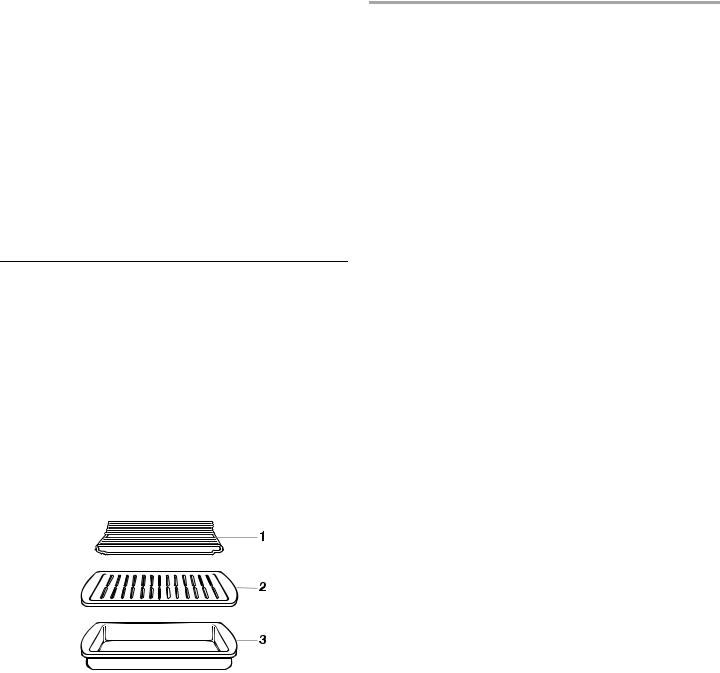
To Convection Auto Bake:
1.Press CONVECTION AUTO BAKE.
Set the temperature to the standard non-convection cooking temperature for the food being cooked.
The oven control will automatically adjust the correct convection cooking temperature when cooking starts.
2.Press START.
The oven control will automatically reduce the cooking temperature from the standard cooking temperature to the correct convection cooking temperature.
The electronic oven control will automatically set the preheat time based on the temperature you have selected and will be seen counting down in the display.
During the preheat time, the oven temperature will rise to the selected temperature and when the temperature is reached, the temperature will replace “PrE” on the display.
3.Press OFF when finished cooking.
Convection Roast
(onsomemodels)
Convection roasting can be used for roasting meats and poultry, or for baking yeast breads and loaf cakes using a single rack. During convection roasting, the bake and broil elements will cycle on and off in intervals to maintain oven temperature, while the fan constantly circulates the hot air.
To Convection Roast:
Before convection roasting, position racks according to the “Positioning Racks and Bakeware” section. It is not necessary to wait for the oven to preheat before putting food in, unless recommended in the recipe.
Use the roasting rack on top of the broiler pan and grid. This holds the food above the grid and allows air to circulate completely around all surfaces.
1.Roasting rack
2.Broiler grid
3.Broil pan
1.Press CONVECTION ROAST.
Press the TEMP “up” or “down” arrow pads (buttons) to enter a temperature other than 350°F (175°C).
2.Press START.
As the temperature rises to the set temperature, “PrE” appears on the display. When the set temperature is reached, the temperature will replace “PrE” on the display.
When the set temperature is reached, if on, one tone will sound.
3.Press OFF when finished cooking.
CONVECTION ROASTING CHART
Food/Rack |
Cook Time |
Oven Temp. |
Internal |
Position |
(min. per |
|
Food Temp. |
|
1 lb [454 g]) |
|
|
|
|
|
|
Beef, Rack Position 2 |
|
|
|
|
|
|
|
Rib Roast |
|
|
|
rare |
20-25 |
|
140°F (60°C) |
medium |
25-30 |
300°F (149°C) |
160°F (71°C) |
well done |
30-35 |
|
170°F (77°C) |
Rib Roast |
|
|
|
(boneless) |
|
|
|
rare |
22-25 |
|
140°F (60°C) |
medium |
27-30 |
300°F (149°C) |
160°F (71°C) |
well done |
32-35 |
|
170°F (77°C) |
Rump, |
|
|
|
Sirloin Tip |
|
|
|
Roast |
|
|
|
rare |
20-25 |
|
140°F (60°C) |
medium |
25-30 |
300°F (149°C) |
160°F (71°C) |
well done |
30-35 |
|
170°F (77°C) |
Meat Loaf |
20-25 |
325°F (163°C) |
165°F (74°C) |
|
|
|
|
Veal, Rack Position 2 |
|
|
|
|
|
|
|
Loin, Rib, |
|
|
|
Rump |
|
|
|
Roast |
|
|
|
medium |
25-35 |
325°F (163°C |
160°F (71°C) |
well done |
30-40 |
|
170°F (77°C) |
|
|
|
|
Pork, Rack Position 2 |
|
|
|
|
|
|
|
Loin Roast |
30-40 |
325°F (163°C) |
160°F-170°F |
(boneless) |
|
|
(71°C-77°C) |
Shoulder |
35-40 |
325°F (163°C) |
160°F-170°F |
Roast |
|
|
(71°C-77°C) |
|
|
|
|
Ham, Rack Position 2 |
|
|
|
|
|
|
|
Fresh |
25-35 |
300°F (149°C) |
160°F (71°C) |
(uncooked) |
|
|
|
Fully |
15-20 |
300°F (149°C) |
160°F (71°C) |
Cooked |
|
|
|
|
|
|
|
Lamb, Rack Position 2 |
|
|
|
|
|
|
|
Leg, |
|
|
|
Shoulder |
|
|
|
Roast |
|
|
|
medium |
25-30 |
300°F (149°C) |
160°F (71°C) |
well done |
30-35 |
|
170°F (77°C) |
|
|
|
|
Chicken*, Rack Position 2 |
|
|
|
|
|
|
|
Whole |
|
|
|
3-5 lbs. |
20-25 |
325°F (163°C) |
180°F (82°C) |
(1.5-2.2 kg) |
|
|
|
5-7 lbs. |
15-20 |
325°F (163°C) |
180°F (82°C) |
(2.2-3.1 kg) |
|
|
|
15
